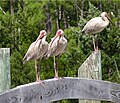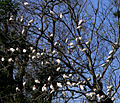American white ibis
| American White Ibis | |
|---|---|

| |
| Scientific classification | |
| Kingdom: | |
| Phylum: | |
| Class: | |
| Order: | |
| Family: | |
| Genus: | |
| Species: | E. albus
|
| Binomial name | |
| Eudocimus albus (Linnaeus, 1758)
| |
American White Ibis (Eudocimus albus) is a species of wading bird of the ibis family Threskiornithidae which occurs from the mid-Atlantic coast of the United States south through most of the New World tropics.
It occurs in marshy wetlands and pools near the coast. It also occurs on mowed grass, lawns, and has become common in some city parks, where it can be found feeding alone or with other Ibis. It builds a stick nest in trees, bushes, or over water, and 2 to 5 eggs are typically laid. White ibises are monogamous and colonial, usually nesting in mixed colonies with other wading species.
This ibis feeds by probing with its long, downcurved beak. Its diet consists of various fish, frogs and other water creatures, as well as insects and small reptiles.
Adults are 65 cm long with a 95 cm wingspan. They have all-white plumage except for black wingtips (visible in flight) and reddish bills and legs. The red bill blends into the face of breeding birds; non-breeding birds show a pink to red face. Juveniles are largely brown with duller bare parts; they are distinguished from the Glossy and White-faced Ibises by white underparts and rumps. Over all both sexes look alike.
Like the other species of ibis, the White Ibis flies with neck and legs outstretched, often in long, loose lines.
The song of the male is an advertising hunk-hunk-hunk-hunk. The female squeals. When feeding, the birds often give a soft, grunting croo, croo, croo as they forage.
This bird hybridizes with the Scarlet Ibis, and they are sometimes considered conspecific.
-
At Sanibel Island, Florida
-
In Florida
-
Adult and juvenile in Florida]].
See also
References
- Template:IUCN2008 Database entry includes justification for why this species is of least concern
- Alsop, Fred J. III; Birds of Texas. Smithsonian Handbooks: DK Publishing, Inc., New York, NY (2002).
External links
- White Ibis page at Nearctica
- White Ibis Species Account - Cornell Lab of Ornithology
- White Ibis - Eudocimus albus - USGS Patuxent Bird Identification InfoCenter
- White Ibis Information - South Dakota Birds and Birding





![Adult and juvenile in Florida]].](http://upload.wikimedia.org/wikipedia/commons/thumb/5/51/AmericanWhiteIbis%26juv.jpg/120px-AmericanWhiteIbis%26juv.jpg)